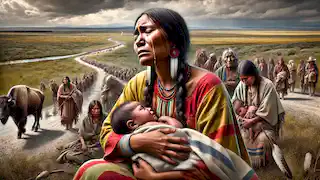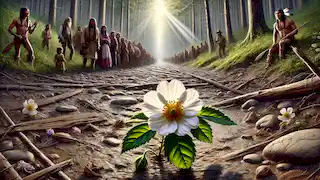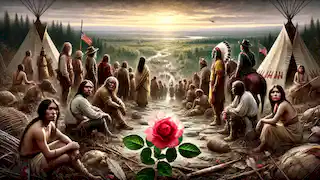The Legend of the Cherokee Rose
Reading Time: 8 min

About Story: The Legend of the Cherokee Rose is a Legend from united-states set in the 19th Century. This Dramatic tale explores themes of Perseverance and is suitable for All Ages. It offers Cultural insights. A journey of sorrow turned into a symbol of hope and resilience.
The Cherokee Rose, known for its simple yet striking beauty, is a symbol of hope, resilience, and survival. The legend associated with this flower is rooted in a time of immense pain and sorrow for the Cherokee people, a Native American tribe that faced an arduous journey across the United States. As the settlers expanded westward, the Cherokee were forced to leave their ancestral lands and march on what is now famously known as the Trail of Tears. This story dives deep into that time, blending history and folklore to bring forth the legend of the Cherokee Rose. The year was 1838, and the land was soaked with the sadness of displacement. The Cherokee Nation, which had lived in harmony with the land for centuries, was now facing the threat of removal. The U.S. government, driven by the pursuit of land and expansion, issued an order that left the Cherokee people no choice but to abandon their homes. Men, women, and children gathered what little they could carry, preparing themselves for the journey ahead—a journey that would test their strength, faith, and will to survive. The skies were gray, and an unsettling stillness fell over the forests as the Cherokee elders gathered around a fire, seeking guidance from the Great Spirit. The youngest children huddled close to their mothers, eyes wide with fear and confusion. The whispers of the wind carried messages of grief as if the land itself was mourning for them. They knew this journey would not be an easy one, but the depth of their suffering was still unknown. The first steps of the Trail of Tears were heavy with sadness and uncertainty. More than 16,000 Cherokee men, women, and children began their journey, walking over 1,000 miles through harsh terrain, unpredictable weather, and under the watchful eyes of soldiers who showed little compassion. The biting cold wind cut through their worn-out clothes, and the scorching heat of the sun left their skin blistered and raw. Families struggled to keep up with each other, carrying their elderly on makeshift stretchers and cradling their infants to protect them from the elements. Each step was a struggle, but they moved forward, hoping to find solace at the end of the journey. Hunger gnawed at their stomachs, and thirst parched their throats, yet they continued on, bound together by an unspoken bond of survival. It was on one such day, as they trudged along the dusty paths, that the first Cherokee woman collapsed to the ground, exhausted and overwhelmed by the journey. Her tears flowed freely, soaking the earth beneath her. As others gathered around to comfort her, a grandmother of the tribe stepped forward. Her voice was soft, but it carried the weight of generations. "My child," she said, kneeling beside the weeping woman, "do not let despair consume you. The Great Spirit watches over us, even in our darkest moments." But as she spoke, she too felt her strength waning, and tears welled up in her eyes. It was then that the eldest elder, a man named Atohi, raised his voice to the heavens, praying for a sign of hope. As days turned into weeks, the Cherokee women began to cry, mourning for their children who were lost to illness, hunger, or the unforgiving journey. Their tears fell to the ground, creating small pools of sorrow that mingled with the dirt. They cried for the children who could no longer laugh, for the homes they had left behind, and for the lives that had been torn apart by forces beyond their control. One night, under the light of a pale moon, a young mother named Ayita cradled her daughter, who had fallen ill. Her daughter's once bright eyes had dimmed, and her breathing was faint. Ayita wept silently, her tears falling onto her daughter's pale cheeks. The Cherokee women gathered around her, their own sorrow reflected in their eyes. In response to their collective pain, the Great Spirit appeared in a vision to one of the Cherokee elders. He spoke in a gentle, reassuring tone, saying, "Your journey is filled with suffering, but do not lose hope. From your tears will come a sign of your endurance and strength. As long as you move forward, life will blossom again." The next morning, as the Cherokee people prepared to continue their journey, they noticed a small, delicate flower blooming along the path. Its petals were white as snow, and its center was golden, shining with a radiant warmth. The thorns that surrounded it were sharp, but the beauty of the flower was undeniable. "Look," one of the women said, pointing to the flower. "It is a gift from the Great Spirit. It is a sign that even in the darkest of times, there is hope." The Cherokee called this flower "The Cherokee Rose," and it quickly became a symbol of their resilience and spirit. As they continued their journey, the rose seemed to spring up wherever the tears of the women had fallen, reminding them that their pain was not in vain. The Cherokee Rose began to appear more frequently along the trail, bringing a glimmer of hope to the weary travelers. Each time they saw its delicate petals, they felt a renewed sense of strength. Mothers would pick the roses and braid them into their children's hair, telling them, "This flower is a reminder of our strength, our history, and our survival." As the journey grew more difficult, with the biting cold of winter and the harsh heat of summer, the Cherokee people drew strength from the beauty of the rose. It was said that the spirit of every lost soul lived within the petals, and that as long as the rose bloomed, the memory of the Cherokee Nation would endure. After months of hardship, suffering, and loss, the Cherokee finally reached the land that had been designated for them. It was not the lush, green home they had known, but a place that would require rebuilding and adaptation. Despite the desolation that greeted them, they took solace in the sight of the Cherokee Rose blooming in this new land, as if welcoming them to their new beginning. The Cherokee people planted the roses around their new homes, nurturing them as they nurtured their spirits. With time, the Cherokee Rose spread, covering the hills and valleys, a testament to the resilience of a people who refused to be forgotten. The Cherokee Rose became a part of their identity, a living symbol of their strength and endurance. It reminded them that even in the face of unimaginable pain, they had survived. It served as a reminder to future generations that they came from a people who had walked a trail of tears and emerged on the other side, still standing, still proud, and still connected to the land. Generations have passed since the Cherokee walked the Trail of Tears, but the story of the Cherokee Rose continues to be told. It is shared with each new generation as a reminder of the strength, courage, and perseverance that defines the Cherokee people. The rose itself still blooms across the southeastern United States, its white petals and golden center standing as a beacon of hope for all who see it. Today, the Cherokee Rose is the state flower of Georgia, chosen not only for its beauty but also for the profound story it carries. It serves as a reminder of the resilience of the human spirit, the power of hope, and the enduring strength of a people who refused to be broken by adversity. The Legend of the Cherokee Rose is a tale of pain and sorrow, but it is also one of hope, resilience, and survival. It reminds us that even in our darkest moments, there is always the possibility of beauty, growth, and renewal. The Cherokee Rose stands as a testament to the enduring spirit of a people who, despite being uprooted and scattered, found a way to bloom again. The story lives on, much like the Cherokee Rose itself, teaching us that hope can take root in the most unexpected places and that from the deepest sorrow, something beautiful can emerge.The Arrival of Despair

The Long Walk Begins
A Mother's Tears

The Gift of the Great Spirit
Hope Along the Way

The End of the Trail
The Legacy of the Cherokee Rose

Conclusion

















